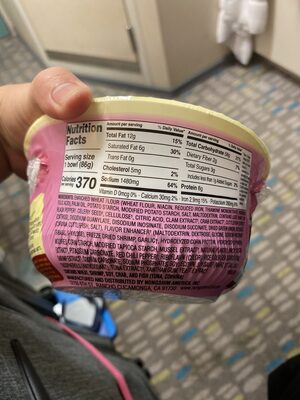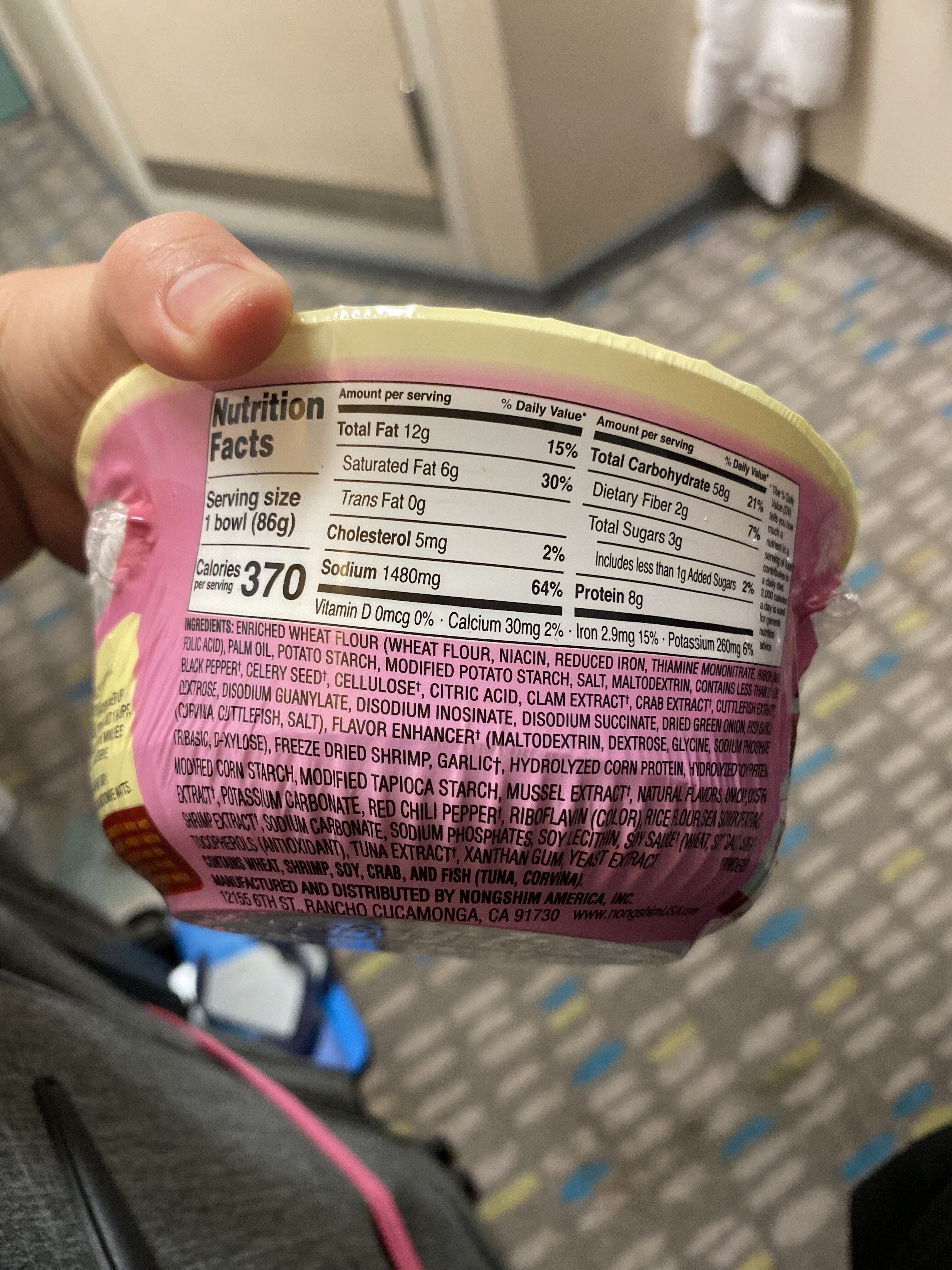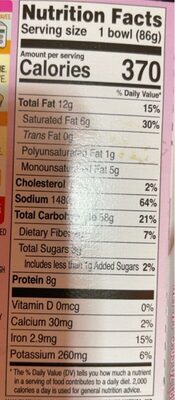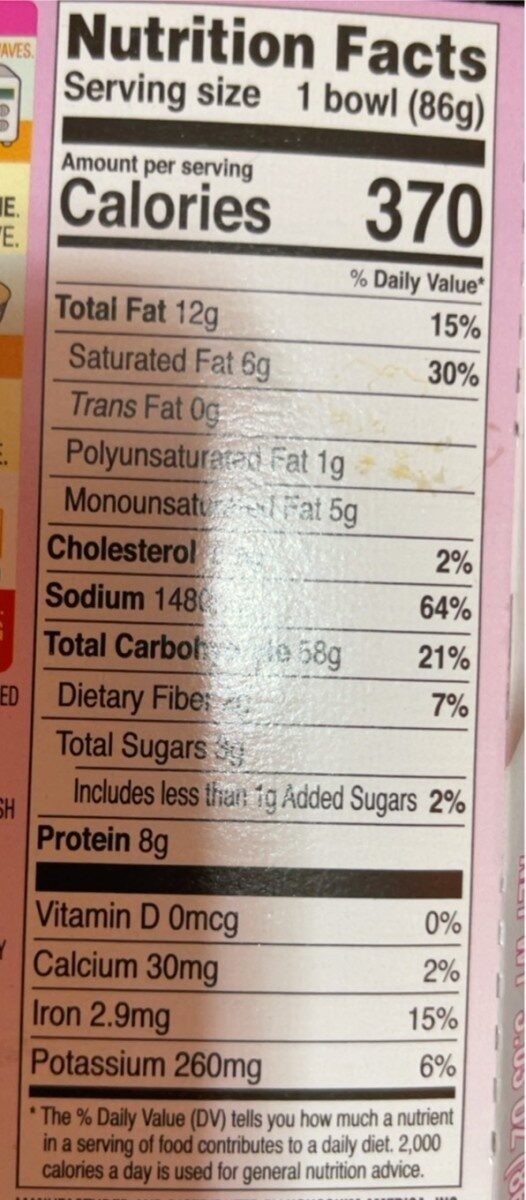Help us make food transparency the norm!
As a non-profit organization, we depend on your donations to continue informing consumers around the world about what they eat.
The food revolution starts with you!
Savory noodle bowl - Nongshim
Savory noodle bowl - Nongshim
This product page is not complete. You can help to complete it by editing it and adding more data from the photos we have, or by taking more photos using the app for Android or iPhone/iPad. Thank you!
×
Barcode: 0031146007592 (EAN / EAN-13) 031146007592 (UPC / UPC-A)
Brands: Nongshim, Nongshim America Inc.
Countries where sold: United States
Matching with your preferences
Health
Ingredients
-
52 ingredients
Wheat flour, palm oil, potato starch, modified potato starch, salt, maltodextrin, contains less than 2% of each of the following: beef fat*, black pepper*, caramel*, celery seed*, clam*, corn syrup*, crab*, cuttlefish*, dehydrated green onion, dextrose, disodium guanylate, disodium inosinate, disodium succinate, fish sauce* (corvina, cuttlefish, salt), freeze dried shrimp, garlic*, hydrolyzed soy protein, japanese parsley*, modified corn starch, mussel*, natural flavors, onion*, oyster extract*, potassium carbonate, radish*, red chili pepper*, riboflavin (color), rice*, sand lance concentrate*, sea squirt*, seaweed extract*, shrimp*, sodium carbonate, sodium phosphates, soybeans*, sugar, tocopherols (antioxidant), tuna*, xanthan gum, yeast extract.Allergens: Crustaceans, Fish, Gluten, Molluscs, Soybeans
Food processing
-
Ultra processed foods
Elements that indicate the product is in the 4 - Ultra processed food and drink products group:
- Additive: E101 - Riboflavin
- Additive: E415 - Xanthan gum
- Additive: E627 - Disodium guanylate
- Additive: E631 - Disodium inosinate
- Ingredient: Colour
- Ingredient: Dextrose
- Ingredient: Flavouring
- Ingredient: Glucose
- Ingredient: Maltodextrin
Food products are classified into 4 groups according to their degree of processing:
- Unprocessed or minimally processed foods
- Processed culinary ingredients
- Processed foods
- Ultra processed foods
The determination of the group is based on the category of the product and on the ingredients it contains.
Additives
-
E101 - Riboflavin
Riboflavin: Riboflavin, also known as vitamin B2, is a vitamin found in food and used as a dietary supplement. Food sources include eggs, green vegetables, milk and other dairy product, meat, mushrooms, and almonds. Some countries require its addition to grains. As a supplement it is used to prevent and treat riboflavin deficiency and prevent migraines. It may be given by mouth or injection.It is nearly always well tolerated. Normal doses are safe during pregnancy. Riboflavin is in the vitamin B group. It is required by the body for cellular respiration.Riboflavin was discovered in 1920, isolated in 1933, and first made in 1935. It is on the World Health Organization's List of Essential Medicines, the most effective and safe medicines needed in a health system. Riboflavin is available as a generic medication and over the counter. In the United States a month of supplements costs less than 25 USD.Source: Wikipedia
-
E101i - Riboflavin
Riboflavin: Riboflavin, also known as vitamin B2, is a vitamin found in food and used as a dietary supplement. Food sources include eggs, green vegetables, milk and other dairy product, meat, mushrooms, and almonds. Some countries require its addition to grains. As a supplement it is used to prevent and treat riboflavin deficiency and prevent migraines. It may be given by mouth or injection.It is nearly always well tolerated. Normal doses are safe during pregnancy. Riboflavin is in the vitamin B group. It is required by the body for cellular respiration.Riboflavin was discovered in 1920, isolated in 1933, and first made in 1935. It is on the World Health Organization's List of Essential Medicines, the most effective and safe medicines needed in a health system. Riboflavin is available as a generic medication and over the counter. In the United States a month of supplements costs less than 25 USD.Source: Wikipedia
-
E363 - Succinic acid
Succinic acid: Succinic acid -- is a dicarboxylic acid with the chemical formula -CH2-2-CO2H-2. The name derives from Latin succinum, meaning amber. In living organisms, succinic acid takes the form of an anion, succinate, which has multiple biological roles as a metabolic intermediate being converted into fumarate by the enzyme succinate dehydrogenase in complex 2 of the electron transport chain which is involved in making ATP, and as a signaling molecule reflecting the cellular metabolic state. Succinate is generated in mitochondria via the tricarboxylic acid cycle -TCA-, an energy-yielding process shared by all organisms. Succinate can exit the mitochondrial matrix and function in the cytoplasm as well as the extracellular space, changing gene expression patterns, modulating epigenetic landscape or demonstrating hormone-like signaling. As such, succinate links cellular metabolism, especially ATP formation, to the regulation of cellular function. Dysregulation of succinate synthesis, and therefore ATP synthesis, happens in some genetic mitochondrial diseases, such as Leigh syndrome, and Melas syndrome, and degradation can lead to pathological conditions, such as malignant transformation, inflammation and tissue injury.Source: Wikipedia
-
E415 - Xanthan gum
Xanthan gum (E415) is a natural polysaccharide derived from fermented sugars, often used in the food industry as a thickening and stabilizing agent.
This versatile food additive enhances texture and prevents ingredient separation in a wide range of products, including salad dressings, sauces, and gluten-free baked goods.
It is considered safe for consumption even at high intake amounts.
-
E500 - Sodium carbonates
Sodium carbonates (E500) are compounds commonly used in food preparation as leavening agents, helping baked goods rise by releasing carbon dioxide when they interact with acids.
Often found in baking soda, they regulate the pH of food, preventing it from becoming too acidic or too alkaline. In the culinary world, sodium carbonates can also enhance the texture and structure of foods, such as noodles, by modifying the gluten network.
Generally recognized as safe, sodium carbonates are non-toxic when consumed in typical amounts found in food.
-
E500i - Sodium carbonate
Sodium carbonate: Sodium carbonate, Na2CO3, -also known as washing soda, soda ash and soda crystals, and in the monohydrate form as crystal carbonate- is the water-soluble sodium salt of carbonic acid. It most commonly occurs as a crystalline decahydrate, which readily effloresces to form a white powder, the monohydrate. Pure sodium carbonate is a white, odorless powder that is hygroscopic -absorbs moisture from the air-. It has a strongly alkaline taste, and forms a moderately basic solution in water. Sodium carbonate is well known domestically for its everyday use as a water softener. Historically it was extracted from the ashes of plants growing in sodium-rich soils, such as vegetation from the Middle East, kelp from Scotland and seaweed from Spain. Because the ashes of these sodium-rich plants were noticeably different from ashes of timber -used to create potash-, they became known as "soda ash". It is synthetically produced in large quantities from salt -sodium chloride- and limestone by a method known as the Solvay process. The manufacture of glass is one of the most important uses of sodium carbonate. Sodium carbonate acts as a flux for silica, lowering the melting point of the mixture to something achievable without special materials. This "soda glass" is mildly water-soluble, so some calcium carbonate is added to the melt mixture to make the glass produced insoluble. This type of glass is known as soda lime glass: "soda" for the sodium carbonate and "lime" for the calcium carbonate. Soda lime glass has been the most common form of glass for centuries. Sodium carbonate is also used as a relatively strong base in various settings. For example, it is used as a pH regulator to maintain stable alkaline conditions necessary for the action of the majority of photographic film developing agents. It acts as an alkali because when dissolved in water, it dissociates into the weak acid: carbonic acid and the strong alkali: sodium hydroxide. This gives sodium carbonate in solution the ability to attack metals such as aluminium with the release of hydrogen gas.It is a common additive in swimming pools used to raise the pH which can be lowered by chlorine tablets and other additives which contain acids. In cooking, it is sometimes used in place of sodium hydroxide for lyeing, especially with German pretzels and lye rolls. These dishes are treated with a solution of an alkaline substance to change the pH of the surface of the food and improve browning. In taxidermy, sodium carbonate added to boiling water will remove flesh from the bones of animal carcasses for trophy mounting or educational display. In chemistry, it is often used as an electrolyte. Electrolytes are usually salt-based, and sodium carbonate acts as a very good conductor in the process of electrolysis. In addition, unlike chloride ions, which form chlorine gas, carbonate ions are not corrosive to the anodes. It is also used as a primary standard for acid-base titrations because it is solid and air-stable, making it easy to weigh accurately.Source: Wikipedia
-
E501 - Potassium carbonates
Potassium carbonate: Potassium carbonate -K2CO3- is a white salt, which is soluble in water -insoluble in ethanol- and forms a strongly alkaline solution. It can be made as the product of potassium hydroxide's absorbent reaction with carbon dioxide. It is deliquescent, often appearing a damp or wet solid. Potassium carbonate is used in the production of soap and glass.Source: Wikipedia
-
E501i - Potassium carbonate
Potassium carbonate: Potassium carbonate -K2CO3- is a white salt, which is soluble in water -insoluble in ethanol- and forms a strongly alkaline solution. It can be made as the product of potassium hydroxide's absorbent reaction with carbon dioxide. It is deliquescent, often appearing a damp or wet solid. Potassium carbonate is used in the production of soap and glass.Source: Wikipedia
-
E627 - Disodium guanylate
Disodium guanylate: Disodium guanylate, also known as sodium 5'-guanylate and disodium 5'-guanylate, is a natural sodium salt of the flavor enhancing nucleotide guanosine monophosphate -GMP-. Disodium guanylate is a food additive with the E number E627. It is commonly used in conjunction with glutamic acid. As it is a fairly expensive additive, it is not used independently of glutamic acid; if disodium guanylate is present in a list of ingredients but MSG does not appear to be, it is likely that glutamic acid is provided as part of another ingredient such as a processed soy protein complex. It is often added to foods in conjunction with disodium inosinate; the combination is known as disodium 5'-ribonucleotides. Disodium guanylate is produced from dried seaweed and is often added to instant noodles, potato chips and other snacks, savory rice, tinned vegetables, cured meats, and packaged soup.Source: Wikipedia
-
E631 - Disodium inosinate
Disodium inosinate: Disodium inosinate -E631- is the disodium salt of inosinic acid with the chemical formula C10H11N4Na2O8P. It is used as a food additive and often found in instant noodles, potato chips, and a variety of other snacks. Although it can be obtained from bacterial fermentation of sugars, it is often commercially prepared from animal sources.Source: Wikipedia
Ingredients analysis
-
Palm oil
Ingredients that contain palm oil: Palm oil
-
Non-vegan
Non-vegan ingredients: Beef fat, Clam, Crab, Cuttlefish, Fish sauce, Corvina, Cuttlefish, Shrimp, Mussel, Oyster, Sea squirt, Shrimp, TunaSome ingredients could not be recognized.
We need your help!
You can help us recognize more ingredients and better analyze the list of ingredients for this product and others:
- Edit this product page to correct spelling mistakes in the ingredients list, and/or to remove ingredients in other languages and sentences that are not related to the ingredients.
- Add new entries, synonyms or translations to our multilingual lists of ingredients, ingredient processing methods, and labels.
If you would like to help, join the #ingredients channel on our Slack discussion space and/or learn about ingredients analysis on our wiki. Thank you!
-
Non-vegetarian
Non-vegetarian ingredients: Beef fat, Clam, Crab, Cuttlefish, Fish sauce, Corvina, Cuttlefish, Shrimp, Mussel, Oyster, Sea squirt, Shrimp, TunaSome ingredients could not be recognized.
We need your help!
You can help us recognize more ingredients and better analyze the list of ingredients for this product and others:
- Edit this product page to correct spelling mistakes in the ingredients list, and/or to remove ingredients in other languages and sentences that are not related to the ingredients.
- Add new entries, synonyms or translations to our multilingual lists of ingredients, ingredient processing methods, and labels.
If you would like to help, join the #ingredients channel on our Slack discussion space and/or learn about ingredients analysis on our wiki. Thank you!
-
Details of the analysis of the ingredients
We need your help!
Some ingredients could not be recognized.
We need your help!
You can help us recognize more ingredients and better analyze the list of ingredients for this product and others:
- Edit this product page to correct spelling mistakes in the ingredients list, and/or to remove ingredients in other languages and sentences that are not related to the ingredients.
- Add new entries, synonyms or translations to our multilingual lists of ingredients, ingredient processing methods, and labels.
If you would like to help, join the #ingredients channel on our Slack discussion space and/or learn about ingredients analysis on our wiki. Thank you!
: Wheat flour, palm oil, potato starch, modified potato starch, salt, maltodextrin, contains less than 2% of each of the following (beef fat), black pepper, caramel, celery seed, clam, corn syrup, crab, cuttlefish, green onion, dextrose, disodium guanylate, disodium inosinate, disodium succinate, fish sauce (corvina, cuttlefish, salt), shrimp, garlic, hydrolyzed soy protein, japanese parsley, modified corn starch, mussel, natural flavors, onion, oyster, potassium carbonate, radish, red chili pepper, riboflavin (color), rice, sand lance concentrate, sea squirt, seaweed extract, shrimp, sodium carbonate, sodium phosphates, soybeans, sugar, tocopherols (antioxidant), tuna, xanthan gum, yeast extract- Wheat flour -> en:wheat-flour - vegan: yes - vegetarian: yes - ciqual_proxy_food_code: 9410 - percent_min: 2.17391304347826 - percent_max: 100
- palm oil -> en:palm-oil - vegan: yes - vegetarian: yes - from_palm_oil: yes - ciqual_food_code: 16129 - percent_min: 0 - percent_max: 50
- potato starch -> en:potato-starch - vegan: yes - vegetarian: yes - ciqual_proxy_food_code: 9510 - percent_min: 0 - percent_max: 33.3333333333333
- modified potato starch -> en:modified-potato-starch - vegan: yes - vegetarian: yes - ciqual_proxy_food_code: 9510 - percent_min: 0 - percent_max: 25
- salt -> en:salt - vegan: yes - vegetarian: yes - ciqual_food_code: 11058 - percent_min: 0 - percent_max: 0.40697674418605
- maltodextrin -> en:maltodextrin - vegan: yes - vegetarian: yes - percent_min: 0 - percent_max: 0.40697674418605
- contains less than 2% of each of the following -> en:contains-less-than-2-of-each-of-the-following - percent_min: 0 - percent_max: 0.40697674418605
- beef fat -> en:beef-fat - vegan: no - vegetarian: no - from_palm_oil: maybe - percent_min: 0 - percent_max: 0.40697674418605
- black pepper -> en:black-pepper - vegan: yes - vegetarian: yes - ciqual_food_code: 11015 - percent_min: 0 - percent_max: 0.40697674418605
- caramel -> en:e150 - vegan: yes - vegetarian: yes - percent_min: 0 - percent_max: 0.40697674418605
- celery seed -> en:celery-seed - vegan: yes - vegetarian: yes - ciqual_proxy_food_code: 20055 - percent_min: 0 - percent_max: 0.40697674418605
- clam -> en:clam - vegan: no - vegetarian: no - percent_min: 0 - percent_max: 0.40697674418605
- corn syrup -> en:corn-syrup - vegan: yes - vegetarian: yes - ciqual_proxy_food_code: 31089 - percent_min: 0 - percent_max: 0.40697674418605
- crab -> en:crab - vegan: no - vegetarian: no - percent_min: 0 - percent_max: 0.40697674418605
- cuttlefish -> en:cuttlefish - vegan: no - vegetarian: no - ciqual_food_code: 10016 - percent_min: 0 - percent_max: 0.40697674418605
- green onion -> en:spring-onion - vegan: yes - vegetarian: yes - ciqual_food_code: 11003 - percent_min: 0 - percent_max: 0.40697674418605
- dextrose -> en:dextrose - vegan: yes - vegetarian: yes - ciqual_proxy_food_code: 31016 - percent_min: 0 - percent_max: 0.40697674418605
- disodium guanylate -> en:e627 - vegan: maybe - vegetarian: maybe - percent_min: 0 - percent_max: 0.40697674418605
- disodium inosinate -> en:e631 - vegan: maybe - vegetarian: maybe - percent_min: 0 - percent_max: 0.40697674418605
- disodium succinate -> en:disodium-succinate - percent_min: 0 - percent_max: 0.40697674418605
- fish sauce -> en:fish-sauce - vegan: no - vegetarian: no - percent_min: 0 - percent_max: 0.40697674418605
- corvina -> en:corvina - vegan: no - vegetarian: no - ciqual_proxy_food_code: 26140 - percent_min: 0 - percent_max: 0.40697674418605
- cuttlefish -> en:cuttlefish - vegan: no - vegetarian: no - ciqual_food_code: 10016 - percent_min: 0 - percent_max: 0.203488372093025
- salt -> en:salt - vegan: yes - vegetarian: yes - ciqual_food_code: 11058 - percent_min: 0 - percent_max: 0.135658914728683
- shrimp -> en:shrimp - vegan: no - vegetarian: no - ciqual_food_code: 10021 - percent_min: 0 - percent_max: 0.40697674418605
- garlic -> en:garlic - vegan: yes - vegetarian: yes - ciqual_food_code: 11000 - percent_min: 0 - percent_max: 0.40697674418605
- hydrolyzed soy protein -> en:hydrolysed-soy-protein - vegan: yes - vegetarian: yes - ciqual_food_code: 20591 - percent_min: 0 - percent_max: 0.40697674418605
- japanese parsley -> en:japanese-parsley - percent_min: 0 - percent_max: 0.40697674418605
- modified corn starch -> en:modified-corn-starch - vegan: yes - vegetarian: yes - ciqual_food_code: 9510 - percent_min: 0 - percent_max: 0.40697674418605
- mussel -> en:mussel - vegan: no - vegetarian: no - ciqual_food_code: 10014 - percent_min: 0 - percent_max: 0.40697674418605
- natural flavors -> en:natural-flavouring - vegan: maybe - vegetarian: maybe - percent_min: 0 - percent_max: 0.40697674418605
- onion -> en:onion - vegan: yes - vegetarian: yes - ciqual_food_code: 20034 - percent_min: 0 - percent_max: 0.40697674418605
- oyster -> en:oyster - vegan: no - vegetarian: no - ciqual_food_code: 10011 - percent_min: 0 - percent_max: 0.40697674418605
- potassium carbonate -> en:e501i - vegan: yes - vegetarian: yes - percent_min: 0 - percent_max: 0.40697674418605
- radish -> en:radish - vegan: yes - vegetarian: yes - ciqual_food_code: 20045 - percent_min: 0 - percent_max: 0.40697674418605
- red chili pepper -> en:red-chili-pepper - vegan: yes - vegetarian: yes - ciqual_food_code: 20151 - percent_min: 0 - percent_max: 0.40697674418605
- riboflavin -> en:e101 - vegan: maybe - vegetarian: yes - percent_min: 0 - percent_max: 0.40697674418605
- color -> en:colour - percent_min: 0 - percent_max: 0.40697674418605
- rice -> en:rice - vegan: yes - vegetarian: yes - ciqual_proxy_food_code: 9100 - percent_min: 0 - percent_max: 0.40697674418605
- sand lance concentrate -> en:sand-lance-concentrate - percent_min: 0 - percent_max: 0.40697674418605
- sea squirt -> en:sea-squirt - vegan: no - vegetarian: no - percent_min: 0 - percent_max: 0.40697674418605
- seaweed extract -> en:seaweed-extract - vegan: yes - vegetarian: yes - ciqual_proxy_food_code: 20984 - percent_min: 0 - percent_max: 0.40697674418605
- shrimp -> en:shrimp - vegan: no - vegetarian: no - ciqual_food_code: 10021 - percent_min: 0 - percent_max: 0.40697674418605
- sodium carbonate -> en:e500i - vegan: yes - vegetarian: yes - percent_min: 0 - percent_max: 0.40697674418605
- sodium phosphates -> en:e339 - vegan: yes - vegetarian: yes - percent_min: 0 - percent_max: 0.40697674418605
- soybeans -> en:soya-bean - vegan: yes - vegetarian: yes - ciqual_food_code: 20901 - percent_min: 0 - percent_max: 0.40697674418605
- sugar -> en:sugar - vegan: yes - vegetarian: yes - ciqual_proxy_food_code: 31016 - percent_min: 0 - percent_max: 0.40697674418605
- tocopherols -> en:e306 - vegan: yes - vegetarian: yes - percent_min: 0 - percent_max: 0.40697674418605
- antioxidant -> en:antioxidant - percent_min: 0 - percent_max: 0.40697674418605
- tuna -> en:tuna - vegan: no - vegetarian: no - ciqual_food_code: 26053 - percent_min: 0 - percent_max: 0.40697674418605
- xanthan gum -> en:e415 - vegan: yes - vegetarian: yes - percent_min: 0 - percent_max: 0.40697674418605
- yeast extract -> en:yeast-extract - vegan: yes - vegetarian: yes - percent_min: 0 - percent_max: 0.40697674418605
Nutrition
-
Missing data to compute the Nutri-Score
Missing category
⚠ ️The category of the product must be specified in order to compute the Nutri-Score.Could you add the information needed to compute the Nutri-Score? Add a category
-
Nutrition facts
Nutrition facts As sold
for 100 g / 100 mlAs sold
per serving (43 g (43 g))Energy 1,800 kj
(430 kcal)774 kj
(185 kcal)Fat 13.953 g 6 g Saturated fat 6.977 g 3 g Trans fat 0 g 0 g Cholesterol 0 mg 0 mg Carbohydrates 67.442 g 29 g Sugars 3.488 g 1.5 g Fiber 2.326 g 1 g Proteins 9.302 g 4 g Salt 0.407 g 0.175 g Vitamin A 0 µg 0 µg Vitamin C (ascorbic acid) 0 mg 0 mg Calcium 0 mg 0 mg Iron 1.67 mg 0.718 mg Fruits‚ vegetables‚ nuts and rapeseed‚ walnut and olive oils (estimate from ingredients list analysis) 1.235 % 1.235 %
Environment
-
Eco-Score not computed - Unknown environmental impact
We could not compute the Eco-Score of this product as it is missing some data, could you help complete it?Could you add a precise product category so that we can compute the Eco-Score? Add a category
Packaging
-
Missing packaging information for this product
⚠ ️ The information about the packaging of this product is not filled in.Take a photo of the recycling information Take a photo of the recycling information
Transportation
-
Origins of ingredients
Missing origins of ingredients information
⚠ ️ The origins of the ingredients of this product are not indicated.
If they are indicated on the packaging, you can modify the product sheet and add them.
If you are the manufacturer of this product, you can send us the information with our free platform for producers.Add the origins of ingredients for this product Add the origins of ingredients for this product
Threatened species
-
Contains palm oil
Drives deforestation and threatens species such as the orangutan
Tropical forests in Asia, Africa and Latin America are destroyed to create and expand oil palm tree plantations. The deforestation contributes to climate change, and it endangers species such as the orangutan, the pigmy elephant and the Sumatran rhino.
Report a problem
-
Incomplete or incorrect information?
Category, labels, ingredients, allergens, nutritional information, photos etc.
If the information does not match the information on the packaging, please complete or correct it. Open Food Facts is a collaborative database, and every contribution is useful for all.
Data sources
Product added on by usda-ndb-import
Last edit of product page on by smoothie-app.
Product page also edited by ecoscore-impact-estimator, kiliweb, yuka.sY2b0xO6T85zoF3NwEKvlktEdevwvDHuDQX5s1CHws2IJYexaPdr_oXhL6s.








